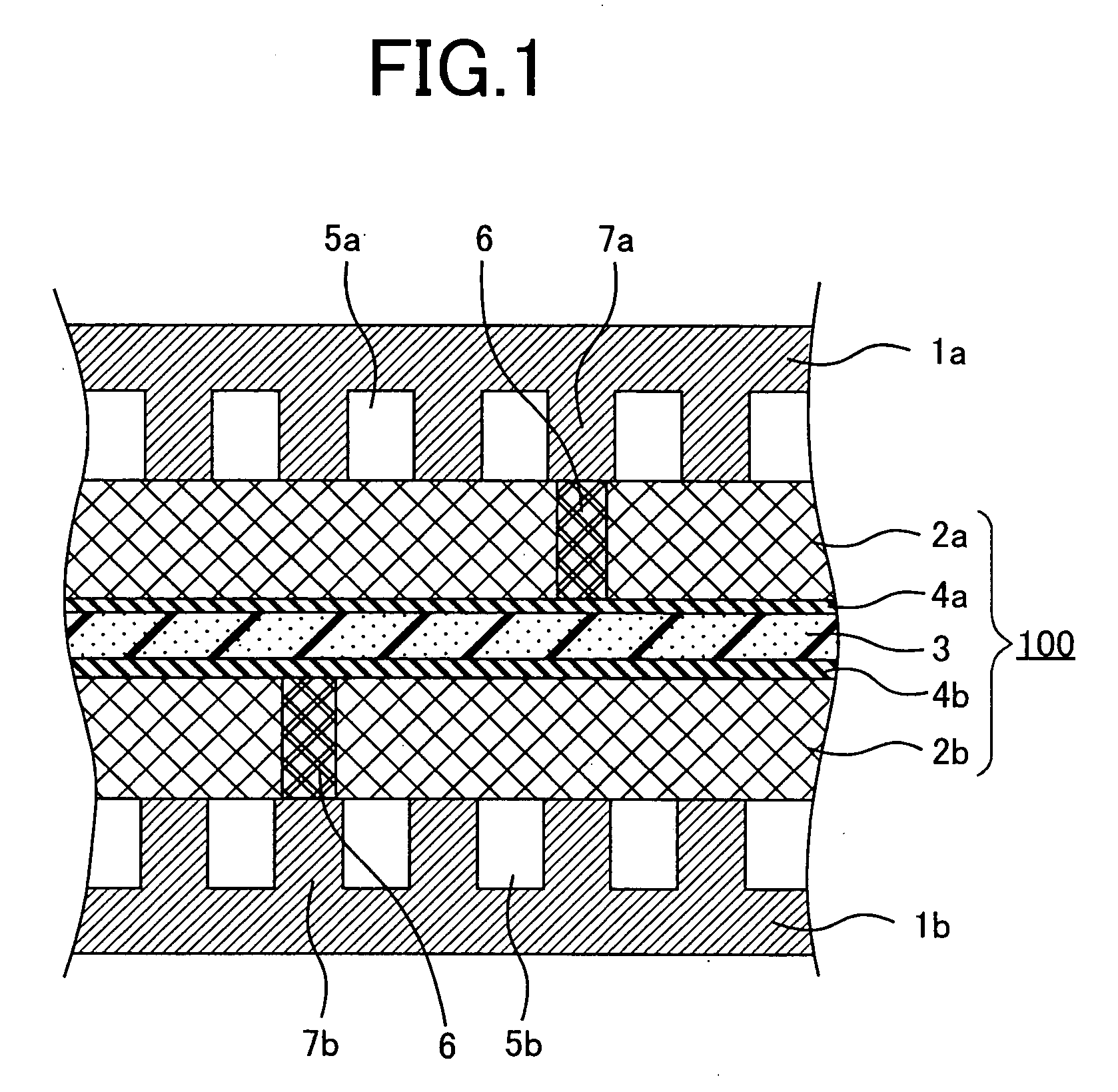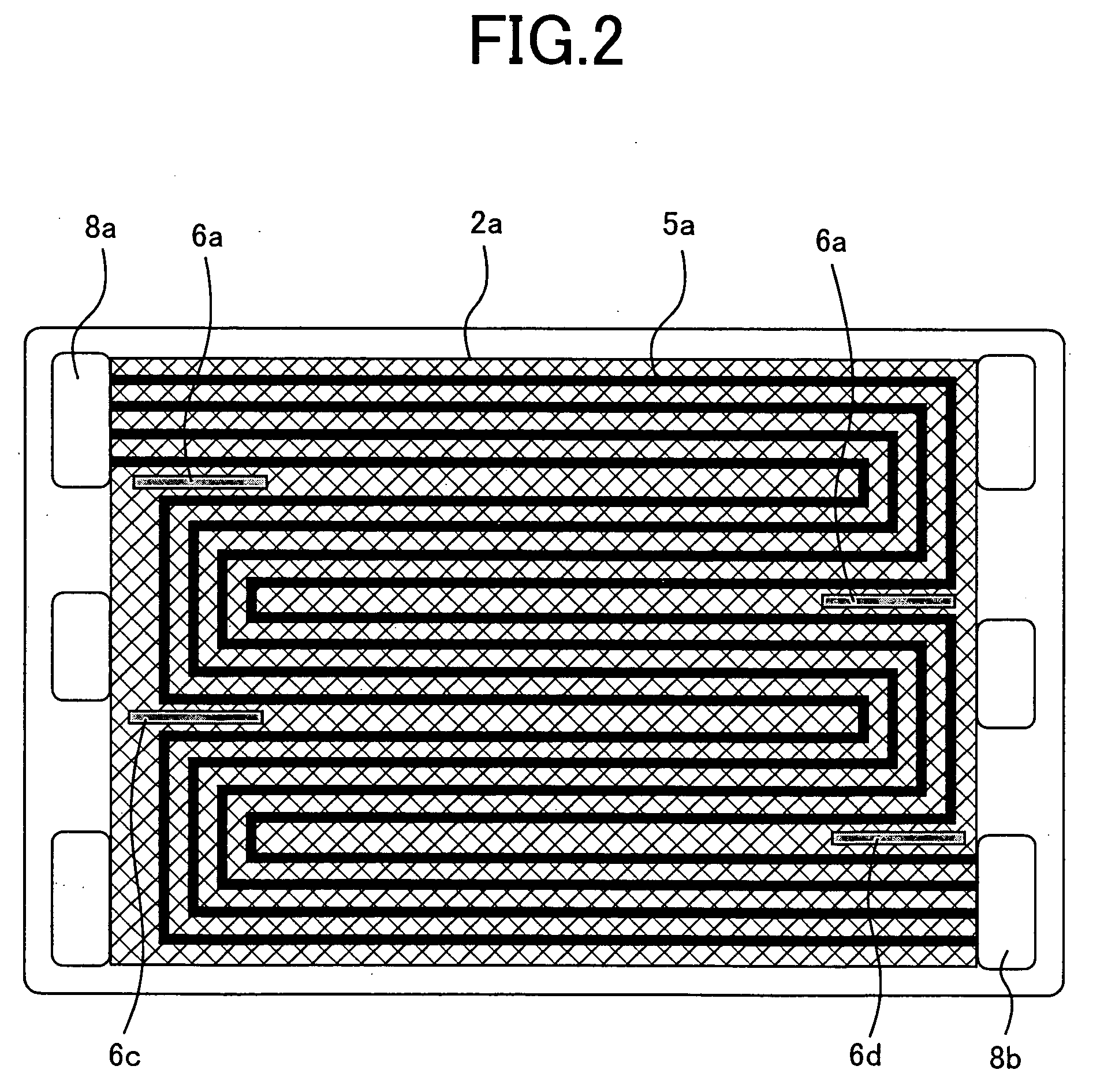Fuel cell
- Summary
- Abstract
- Description
- Claims
- Application Information
AI Technical Summary
Benefits of technology
Problems solved by technology
Method used
Image
Examples
embodiment 1
[0021]FIG. 1FIG. 4 are explanatory views of a fuel cell according to Embodiment 1 of the present invention, and more specifically, FIG. 1 is a sectional view illustrating the simulated appearance of the main members of the fuel cell cut along its stack-layer direction, FIG. 2 is a plan view of an anode gas diffusion layer and an anode-side separator viewed from an anode catalytic layer side, FIG. 3 is a plan view illustrating an enlargement of a portion of FIG. 2, and FIG. 4 is a plan view of the anode gas diffusion layer and the anode-side separator viewed from the anode catalytic layer side.
[0022] As illustrated in FIG. 1, the present embodiment is configured as a seven-layered laminated structure unit built up of, in order, an anode-side (fuel electrode side) separator plate la, an anode gas diffusion layer 2a, an anode catalytic layer 4a, a proton-exchange electrolyte membrane 3, a cathode (oxidizing electrode) catalytic layer 4b, a cathode gas diffusion layer 2b and a cathode-...
embodiment 2
[0060]FIG. 5 is an explanatory plan view of the fuel cell according to Embodiment 2 of the present invention, and more specifically, illustrates the anode gas diffusion layer and the anode-side separator plate viewed from the anode catalytic layer side.
[0061] As illustrated in FIG. 5, the fuel cell according to this embodiment has a plurality of flow channel groups (there are three of them in FIG. 5) in which at least one of either the fuel gas flow path or the oxidizing gas flow path (in FIG. 5, the fuel gas flow path) is configured from a plurality of flow channels 5a (in FIG. 5, six flow channels), and a gas supply manifold (a fuel gas inlet manifold) 8a and a gas discharge manifold (a fuel gas outlet manifold) 8b with which the flow channels 5a commonly communicate, and it is configured so that the gas in neighboring flow channel groups flows in opposing directions.
[0062] Furthermore, among the ridges between the neighboring flow channel groups, resin is impregnated into the h...
embodiment 3
[0070]FIG. 6 is an explanatory plan view of the fuel cell according to Embodiment 3 of the present invention, and more specifically, illustrates the anode gas diffusion layer and the anode-side separator plate viewed from the anode catalytic layer side.
[0071] As illustrated in FIG. 6, the fuel cell according to this embodiment has a plurality of flow channel groups (there are three of them in FIG. 6) in which at least one of either the fuel gas flow path or the oxidizing gas flow path (although only the fuel gas flow path is illustrated in FIG. 6, both flow paths are present in this embodiment) is configured from the flow channels that run in bends (in FIG. 6, three flow channels) and a gas supply manifold (a fuel gas inlet manifold) 8a and a gas discharge manifold (a fuel gas outlet manifold) 8b with which the flow channels commonly communicate, and it is configured so that the gas in neighboring flow channel groups flows in similar directions.
[0072] Furthermore, resin is impregn...
PUM
 Login to View More
Login to View More Abstract
Description
Claims
Application Information
 Login to View More
Login to View More - R&D
- Intellectual Property
- Life Sciences
- Materials
- Tech Scout
- Unparalleled Data Quality
- Higher Quality Content
- 60% Fewer Hallucinations
Browse by: Latest US Patents, China's latest patents, Technical Efficacy Thesaurus, Application Domain, Technology Topic, Popular Technical Reports.
© 2025 PatSnap. All rights reserved.Legal|Privacy policy|Modern Slavery Act Transparency Statement|Sitemap|About US| Contact US: help@patsnap.com



